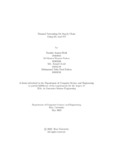Demand forecasting on supply chain using ML and NN
Abstract
Demand forecasting is mainly a process whereby analyzing historical sales data,
strategic and operational strategies are devised in order to estimate customer demand.
One of the most fundamental aspects of supply chain management is inventory
management, its major goal is to cut expenses, boost sales and profits,
optimize inventory, and most importantly, promote customer loyalty. The process
of extrapolating relevant sales data may be separated into qualitative and quantitative
forecasting, with each relying on multiple sources and data sets. When there is
previous sales data on certain items and a predetermined demand, the quantitative
forecasting approach is employed. It necessitates the application of mathematical
formulas as well as data sets such as financial reports, sales, and income numbers,
as well as website analytic. The qualitative technique, on the other hand, is based
on new technologies, pricing and availability changes, product life cycles, product
upgrades and most significantly, the forecasters’ intuition and experience. Machine
learning, clustering, time series analysis, neural networks, KNN, support vector regression,
support vector machines, regression analysis, and deep learning are some
of the approaches used to anticipate demand. A majority of study has gone into
improving demand forecasting, which will enhance supply chain sales and profitability.
To do that the researchers mainly focused on using machine learning or deep
learning as its main methodology and others like support vector algorithm, time
series analysis. However, to our best knowledge, only a handful of research is done
using hybrid model consists of both deep learning and machine learning as its main
methodology. That is why we want to concentrate on using hybrid models to develop
dynamically configurable demand forecasting which eventually will give us
promising results.

